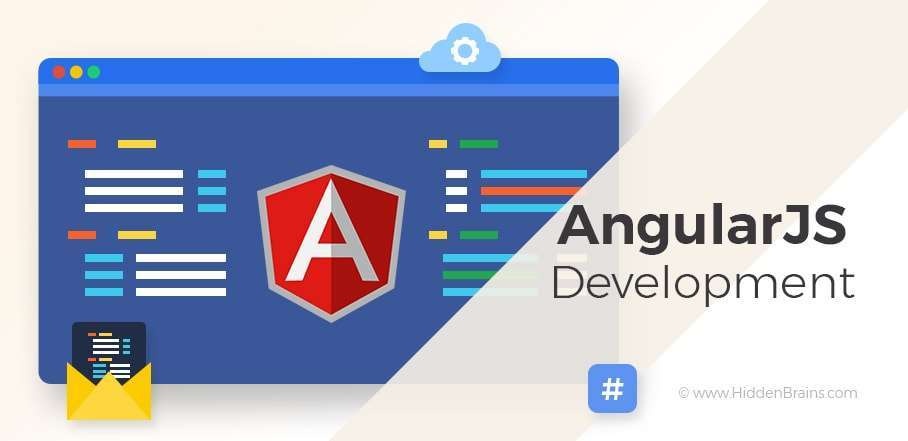Table of Contents
Table of Contents
AngularJS is among the most widely used technologies in Web application development today. For starters, the JavaScript front-end application framework was developed and maintained by Google. If you are looking for a robust app development solution, Angular.js development services may come across as an effective solution. It is a JavaScript-based open-source frontend web framework addressing challenges encountered in developing applications. AngularJS versions are frequently updated and they try to enhance the security and stability of applications.
Let’s discuss the benefits of AngularJS Development :
- Supports a wider community: Developers can figure out the appropriate solution for fixing issues and clients can select the development teams as required. It opens up voluminous opportunities for both app developers and the clients.
- Easy to understand: AngularJS is fairly easy to understand and easy to maintain. It is this simplicity that provides extra benefits where clients can often make changes.
- Custom Solutions: While writing the code, mobile app developers are actually not required to add all the libraries at a time and add some other extra modifications. It comes with readymade and versatile solutions that can be used within the app. Customized solutions such as module practices can be used.
- Comprehensive Testing: AngularJS allows mobile app developers to code as well as create the code from the rest of the app.
How many versions of angular are there?
Here are the AngularJS Versions history, release date, end date, and LTS Support:
| Version | Status | Released | Active Ends | LTS Ends |
|---|---|---|---|---|
| ^12.0.0 | Active | May 12, 2021 | Nov 12, 2021 | Nov 12, 2022 |
| ^11.0.0 | LTS | Nov 11, 2020 | May 11, 2021 | May 11, 2022 |
| ^10.0.0 | LTS | Jun 24, 2020 | Dec 24, 2020 | Dec 24, 2021 |
| ^9.0.0 | Not Supported | Feb 06, 2020 | ||
| ^8.0.0 | Not Supported | May 28, 2019 | ||
| ^7.0.0 | Not Supported | Oct 18, 2018 | ||
| ^6.0.0 | Not Supported | May 04, 2018 | ||
| ^5.0.0 | Not Supported | Nov 01, 2017 | ||
| ^4.0.0 | Not Supported | Mar 23, 2017 | ||
| ^2.0.0 | Not Supported | Dec 16, 2016 | ||
| ^1.0.0 | Not Supported | Oct 20, 2014 | ||
Highlights of AngularJS Version 7
The different features that distinguish Angular 7 from the prior Angular versions include the following:
- Angular Elements components now support content projection via slots.
- Improves app performance by automatically adding or removing the reflect metadata polyfill.
- Angular CLI can prompt users with the CLI Prompts capability to help make decisions. CLI documentation has been integrated into the main Angular.io docs.
- By using the default bundle budgets, users will get warned every time if the app exceeds 2MB. However, in case the initial bundle exceeds 5MB it will show as an error.
Highlights of AngularJS 8
The different features that distinguish Angular 8 from the prior Angular versions include the following:
- For improving compiler performance, the new version now does not allow copying from prototype while cloning an object. This updates the clone function of the ApplySourceSpanTransformer class, in which the for-in loop was used, this used to result in copying from prototype to own properties, utilizing unnecessary memory.
- Talking about Bazel, users will now be able to pass a custom Bazel CompilerHost for an Angular compilation, supporting the overriding of the TypeScript compiler host.
- There is improved support for $element in upgraded component template and templateURL functions.
- The new version also comes with numerous bug fixes that also includes inflating the memory limit of ngc under Bazel from 2GB to 4GB.
What are Angular 9 Features?
Angular introduces Ivy, the new compilation and rendering pipeline. This will make the default value of the Ivy flag “true.” All those applications running ngc compilation now by default receive an Ivy build. The purpose of Ivy is to generate code that is easier to read and debug at runtime and to cater to faster re-builds and enhanced payload size.
Along with making Ivy default, Angular 9.0 (beta) includes the following new features and improvements:
- With the aim to improve performance in the core, sanitization will become tree-shakable in the Ivy renderer. Sanitizer remains optional in Ivy and DomSanitizer is tree-shakable.
- To provide consistency, the DomSanitizer is refactored so that it can use the same functions as Ivy sanitization. There also are small changes in Ivy related to property bindings, saving on processing time. Ivy also gains a performance benefit from changing for-of loops in runtime code to regular for.
- In the core, a schematic is featured that adds a Directive decorator to undecorated classes with fields that use Angular decorators.
- Also in Ivy, template type-checking has been changed to produce ts.diagnostics. This mends a design issue in which the Angular compiler has produced both native TypeScript diagnostics and its own internal diagnostics format, which has not been optimal.
- Also for the core, Angular adds a new migration schematic, as per the given migration plan.
- In Ivy, the DomElementSchema registry is used in ngtsc to check bindings to the DOM.
- Ivy does not read global state when interpolated values do not change. This feature refactors code so the global state (getSelectedIndex()) is not accessed until needed.
What are Angular 10 Features?
- Language Service
- New Date Range Picker
- Warnings About CommonJS Imports
- Ecosystem/Compiler Updates
- Options to Enforce Stricter Settings
- Ngcc
- Performance Improvements
- Angular Team Update
- New Default Browser Config
- Deprecations
- Service Workers
- Typescript 3.9, TSLib 2.9 & TSLint v6
- Localization
- Router
What are Angular 11 Features?
- Faster Builds
- Updates on Operation Byelog
- Angular ESLint Updates
- Internet Explorer Updates
- Experimental Webpack 5 Support
- Improved Logging and Reporting
- Updated Language Service Preview
- Updated Hot Module Replacement (HMR) Support
- Automatic Font Inlining
- Component Test Harnesses
- TypeScript 4.0 Support
- Pipes
- Browser Support/cleaning
- CollectionChangeRecord is deprecated
- Unit Test
- ViewEncapsulation
- Generate E2E test with async/wait
- Support Lazy Loading with Named Outlets
- Feature to Extract i18n tokens from library
- Angular Flex-Layout
- Prompt for Strict Mode
- Angular CLI generator for resolvers
What are Angular 12 Features?
- Ivy Everywhere
- Migrating from legacy i18n message IDs
- Protractor: planning for future
- Nullish Coalescing
- Improvements in styling
- Deprecating support for IE11
- Support from the Community
- Strict by default
- Production build by default
- HTTP improvements
- Metadata for requests and interceptors
- appendAll on HttpParams
- HttpStatusCode
- ng API improvements
- New Dev Tools
- Angular Universal
- Typescript 4.2
- Changes in Tuple Types
- Abstract Construct Signatures
- Improvements for in operator
- Improved Type Alias
- Improvements to the compile process
- Webpack 5.37 support
- Animation
- Compiler – CLI
- Platform browser
How do I upgrade to the latest version of Angular 12?
Run the following command to update to Angular 12 from Angular 11. However, if you have Nx 12.3, note that it already supports Angular 12.
@angular/core@12 @angular/cli@12
Features of AngularJS
Angular 7, is the new major version of the web popular framework released by Google. This latest version offers a host of new features such as CLI Prompts, Angular Budgets, Virtual Scroll, Drag and Drop, and more.
Angular Budgets
This feature of Angular Budgets allows developers to set budget thresholds or limits in Angular.js on configuration and ensures application stays well within limit. Budget has received improvements related to performance in Angular 7. When using the default bundle budgets, users gets warning each and every time the app exceeds 2MB and there will be an error if the initial bundle exceeds 5MB.
The Angular CLI
Angular 7 provides a command-line interface (CLI) tool for developers to initiate, develop and maintain Angular apps to prompt developers to run common commands aiming to help developers discover built-in features.
Drag and Drop
The Drag and Drop component lets developers to build drag and drop functionality in a developer-friendly way. According to Angular team “The @angular/cdk/drag-drop module provides you with a way to easily and declaratively create drag-and-drop interfaces, with support for free dragging, sorting within a list, transferring items between lists, animations, touch devices, custom drag handles, previews, and placeholders, in addition to horizontal lists and locking along an axis”.
Superior performance
The features that make Angular shine among the others are robustness, simple usage, and natural features with competence to develop new functions. All these when work in sync, make Angular the finest preference across the development space.
Angular is extremely power-driven with dedicated features like API Client, Filters, Animations, Routing, Content Sanitization, and Form Validation, directly making web and mobile app development seamless. It saves a lot of time and effort with the ability to enable minor enhancements at greater ease.
AngularJS Use Cases
- On-demand video streaming apps: It is the best choice for developing such apps. The most prominent examples are YouTube and Netflix.
- User Review Apps: These applications provide critical information to the users about the actions they are interested in taking. With review apps, it is easy to identify the best solutions and save resources in terms of money.
- Travel Apps: Since these apps involve dynamic features, AngularJS helps in developing sophisticated travel apps.
- Weather Apps: AngularJS allows the developers to develop an interactive display and helps in performing real-time activities with optimized quality.
- Content portals apps: AngularJS offers the functionality of handling a huge amount of data, posts, and user information.
- Progressive web apps (PWAs): PWAs were first developed by Google somewhere in 2015. The team at Angular foresaw the upcoming popularity of PWAs and started working on facilitating the process of creating PWAs. All the Angular versions after Angular 5 comes equipped with built-in PWA support. New CLI commands in Angular enables developers to turn their web apps into progressive web apps easily.
- Static content and lightweight websites: Angular becomes an ideal choice for those websites that have dynamic content, however it becomes insufficient when you build small pages with static content. In this case, Angular only increases the overall size of the project, thereby increasing the load time significantly. Hence, when you want to build a lightweight website that has static content, Angular is the perfect choice.
- Enterprise web apps: With TypeScript, you get all the features that are required in developing large-scale projects. It is heavily equipped with autocompletion, advanced refactoring, and navigation features and thanks to the architecture of this tool ,maintaining and reusing the code becomes seamless.
- Dynamic content apps: When Angular was built, its primary was to create single-page web applications. Due to this, it has a wide range of tools for SPA development. Angular has just the right amount of technology for websites where the content should change dynamically based on user behavior and preferences. It also has dependency injections that make sure that in case one component gets changed, other components that are related to it also get changed automatically.
Finally
If you are planning to develop and implement high-performance web & mobile technologies, consider Angular as the efficient, up-to-date development framework. AngularJS emerges as a winner in the present time owing to such immense benefits, but one must consult the right AngularJS Development Company or experts before proceeding with app development.










































